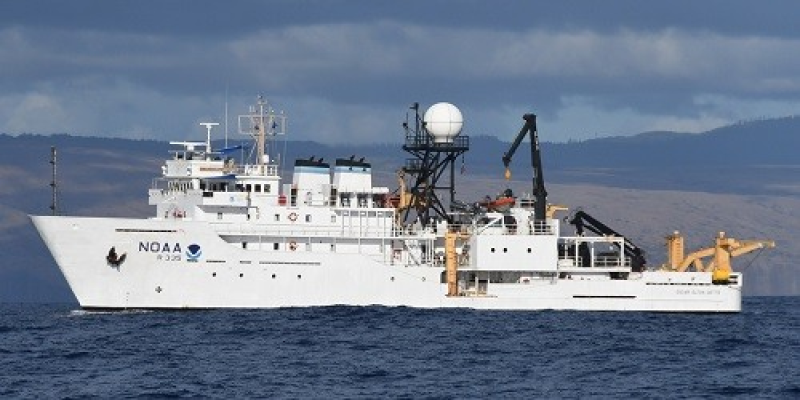On April 5, NOAA researchers will sail aboard the NOAA Ship Oscar Elton Sette to study coral reef biodiversity. The expedition will depart from Pearl Harbor, Oʻahu, and travel to Hawaiʻi Island. The researchers will survey reefs all along the west coast from ʻUpolu Point to South Point, returning to port on April 17.
Researchers plan to measure reef biodiversity using a suite of complementary methods including environmental DNA surveys, benthic 3-dimensional photomosaics, and visual fish counts. Environmental DNA (or eDNA) is a new and rapidly emerging tool for surveying marine ecosystems. As animals move through the ocean, they shed DNA into the water. Like investigators at a crime scene, researchers will try to sample minuscule amounts of DNA left behind by the reef inhabitants. Divers collect 1-gallon samples of water that will be filtered and then preserved back on the ship.
Later in the lab, trace amounts of DNA caught on the filters will be extracted and sequenced for analysis. Using a metabarcoding approach, those DNA sequences detected in each sample will be compared to public reference databases to identify hundreds of species present on each reef.
“eDNA is an incredibly powerful tool that will allow us to survey the entire reef ecosystem, from microbes to megafauna. It helps us document plants and animals that live on the reef that we typically miss with traditional survey methods,” said Jonathan Whitney, co-lead investigator with NOAA’s Pacific Islands Fisheries Science Center. “Using eDNA will allow us to gain a more holistic snapshot of the entire reef ecosystem.”
Whitney is an ecologist and geneticist who studies biodiversity and how marine fish populations are connected.
Teams of divers will also collect scientific data on reef fish and corals using visual surveys and 3 dimensional photomosaic methods. These reef surveys will help verify and complement the results of the environmental DNA analysis. They will also provide important information on the status of individual reefs, such as reef complexity and fish biomass. These combined approaches to surveying reefs provide a detailed and powerful dataset to help assess the status and trends in coral reef health in the region. This integration of methods has never been done at this scale in Hawaiʻi before.
This effort is a collaboration with NOAA, the State of Hawaiʻi Division of Aquatic Resources, the University of Hawaiʻi at Hilo, and Arizona State University. This federal-state-academic collaboration will strengthen partnerships among research institutions and increase information sharing. The combined perspectives and experiences will expand the use and effectiveness of the data collected.
Human Actions Influence Coral Reef Biodiversity
This research is key to monitoring the health and diversity of complex coral reef ecosystems. Coral reefs are some of the most diverse ecosystems on the planet. Yet, researchers are still learning about how many species occur on any given reef and how that changes over space and time. Effective biodiversity monitoring will help close this information gap.
Researchers are also trying to understand and predict how human and natural stressors influence what species are present in an ecosystem. The research expedition will sample along sites with a diversity of habitat types including flat to steep bottom topography, high coral cover to low coral cover, shallow to deep habitat, and a variety of ocean conditions (such as waves and productivity). They will also sample along a gradient of sites with lots of human impact to remote sites with less human impact (such as wastewater pollution and fishing pressure). Some sites will also overlap with existing fish monitoring locations and/or recently surveyed locations. By sampling across varying human and environmental conditions, researchers can compare which sites have higher biodiversity than others.
“Our hope is that eDNA will complement traditional surveys to help us track changes in reef ecosystem health and changes in biodiversity owing to climate change," said Jamison Gove, co-lead with NOAA’s Pacific Islands Fisheries Science Center.
Gove leads the Hawaiʻi Integrated Ecosystem Assessment effort. This is part of a larger NOAA-wide initiative to provide a national approach to understanding and managing ecosystems. The approach brings together social, biological, and physical scientists with stakeholders and managers to manage all aspects of an ecosystem including human needs and activities.
Balancing the Needs of Nature and Human Communities
Understanding the connections between coral reef biodiversity and the human and natural factors that influence it is crucial to conserving coral ecosystems. It is also crucial for balancing the needs of nature and society. The use of integrated science and management will strengthen this balance for current and future generations of Hawaiʻi.
The data collected on this research expedition will establish a baseline of whole reef biodiversity. NOAA and the State of Hawaiʻi will use this data to inform management decisions. Ecosystem-based management is an adaptive, integrated approach to incorporating the entire ecosystem, including humans, into resource management decisions. This requires better information about species that are understudied but can be identified using environmental DNA.
Read more about NOAA’s implementation of environmental DNA as a tool for ecosystem-based fisheries management.
Follow along as researchers cruise along West Hawai'i. Updates will be posted regularly.

